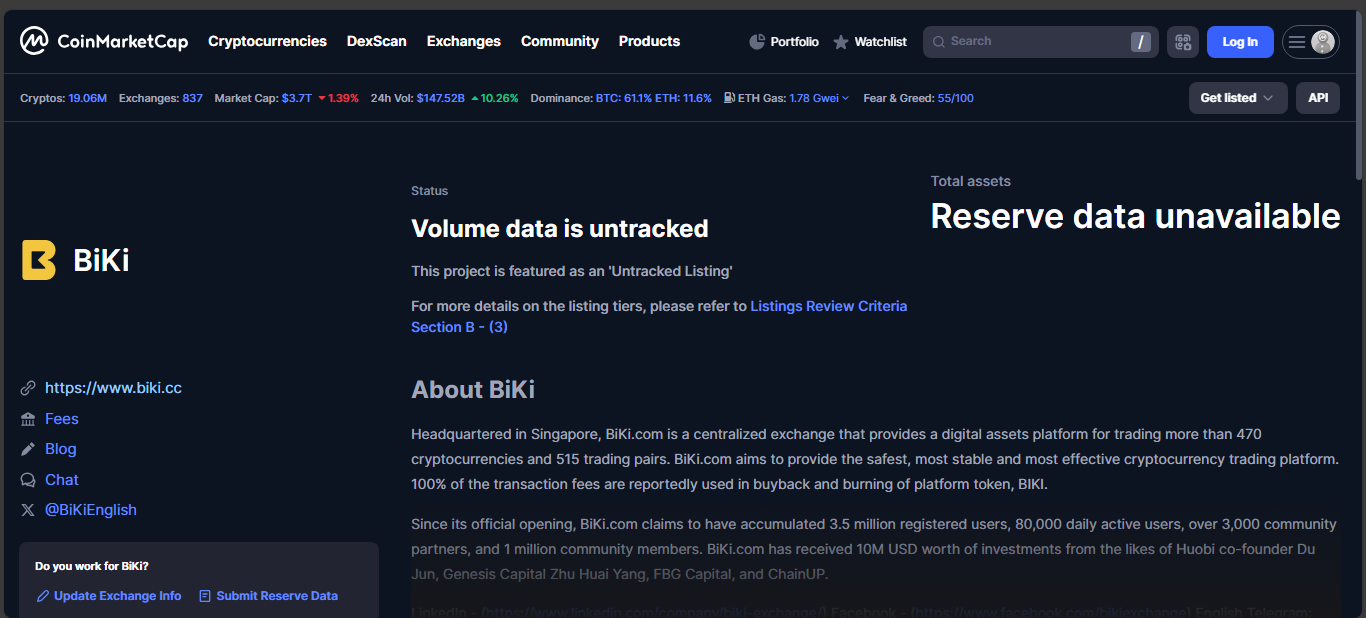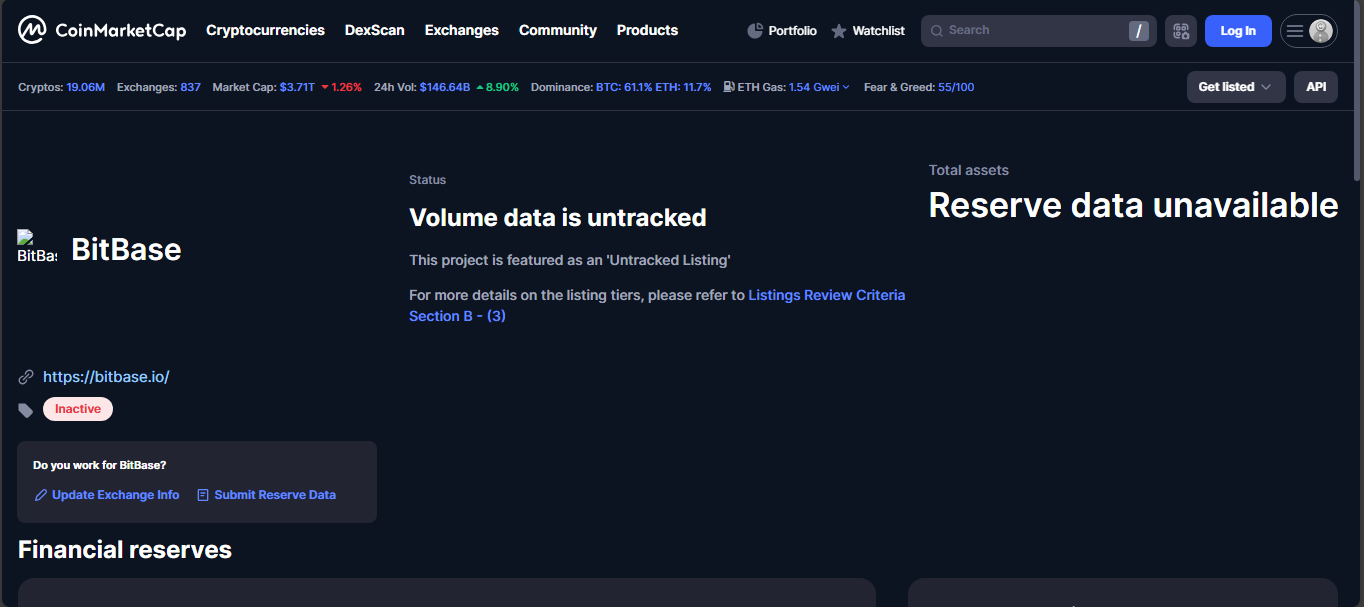ICO Rankings Blog
Discover a wealth of knowledge and stay up-to-date with the latest trends, news, and insights in the cryptocurrency and blockchain space through our blog.
Discover a wealth of knowledge and stay up-to-date with the latest trends, news, and insights in the cryptocurrency and blockchain space through our blog.
Koinex flourished in 2017–2018. At that time, it seemed to be the largest player in the cryptocurrency market in India. Signup was decent, coins were available, and BTC pairs traded actively. The exchange grew fast - on peak days, trading volumes hit hundreds of millions. Then in 2018 RBI issued its crypto banking ban. Things fell apart quickly. Koinex announced closure on June 27, 2019. They said funds would be returned by July 15, and wallets would remain alive for a while. After that, it all faded.
Now the site still shows as an exchange listing, but no markets or volume recorded. Status: untracked, inactive.
Long ago the site bragged about being India’s trusted exchange. Transparency, data alliance, visible volumes, easy deposits and withdrawals. Now none of that shows - only an empty listing and stale archive pages. Most mentions online now just show its shutdown post and how the team promised refunds before leaving.
I opened the Koinex link. Interface still loads but charts blank. No trading panels, no coins, no order books, no volume. Trades tab is empty. Deposit and withdraw options don’t exist. It’s like landing at an airport with no flights or staff.
Scrolling around - they once had blog posts, live chat, support emails. All gone or broken. Search results mostly historical posts and news archives. Few Reddit mentions - a handful of users saying they got their refunds, others saying long delays.
Crypto trackers list Koinex as inactive or untracked, zero volume or pairs. No traffic metrics. No GitHub. No social activity. The overall footprint looks erased.
Articles mention regulatory blockage as the key reason - banking partners pulled out after the RBI ban, liquidity vanished, infrastructure costs remained too high. Most users got withdrawal windows, but that ended in mid-July 2019. After that, Koinex just shut trading and left.
That’s all.
Because it closed permanently. After regulatory pressure, banking support disappeared. Without deposits and withdrawals, users left. Liquidity dried up. The team shut it down. Now there’s only a listing in archives.
An exchange without traders or assets is just an empty catalog. Koinex fell into the pit of regulatory uncertainty and never pulled out.
Honestly? Only someone researching old Indian exchanges. Or someone misclicking expecting to trade. You can’t deposit, won’t trade, won’t withdraw. It’s pointless for anyone today.
Koinex lives in history. Still technically online in directories, but dead as a trading venue. No updates, no community, no market. Just a ghost in the archive.
No. Zero reason. If you somehow find funds there (unlikely after years), you can’t trade. Withdrawals ended long ago. Support doesn’t exist. Better not drop a coin there at all.
Koinex had a quick run and made a mark in India’s early crypto era. Then RBI’s ban, banking closures, uncertain policy collapsed it. Now it exists only on old screenshots and listings. As an exchange, it died six years ago. There’s no market, no trades - it’s just a name and an empty shell.

Stockpoint shows up as an exchange launched in July 2018, based in Tallinn, Estonia. Supposedly it supports around 15 trading pairs and offers fiat and crypto deposits. But when you visit its listing, it is labeled as untracked with no reserve data and no visible volume. That already paints the picture - listed, yes. Active? Doubtful.
On the surface, Stockpoint pitches itself as a clean crypto exchange. Supports fiat deposits, trading of crypto pairs, licensed by Estonian regulator. Sounds fine on paper, but headlines aside, there’s almost zero trace of actual market activity.
I clicked around just to see. The listing page appears, layout is decent. But there’s no market depth, no prices, no volume. Spot markets are empty, charts either broken or blank. Deposit or trade buttons may appear - but you can’t actually do anything. It feels like walking into a nearly deserted station full of terminals but no trains or passengers.
Stockpoint is marked untracked - meaning volume is too low or nonexistent. If activity existed, the classification would change. But Stockpoint stays in limbo. Same site, same inactive status, no updates. Social channels nearly silent. No footprints in forums. Few mention it and almost all say the same - nothing happened there.
That’s it. No order book, no transactions, no liquidity.
Because an exchange without liquidity and trading pairs is pointless. Features don’t matter if nobody uses them. Stockpoint might as well be a brochure with no business behind it. Listings remain, interface loads - but the engine is switched off.
Probably only curious researchers or someone who stumbled in by mistake. Nobody serious signs up or trades there. No markets, no depth, no support.
Stockpoint remains technically online as an untracked exchange in directories. But it shows no volume, no assets, no reserves. Essentially a shell - a ghost interface without transactions or users.
No. Don’t deposit anything. There’s no trading and no liquidity. Worst case, your account just sits there doing nothing. If you find any balance by chance, try logging in and confirming it, but don’t rely on withdrawals. This is not a functioning platform.
Stockpoint had a concept - an Estonian crypto exchange with fiat rails, modest pairings. But it never took off. Now it exists mainly as an untracked listing. The UI loads, the name is there, but there’s zero activity. It’s like a storefront that never opened for business.

SKEX up in late 2019. Singapore, centralized, basic spot and futures trading advertised. Now, if you visit, the webpage loads fine. Tabs appear. But when you scroll - empty markets. No depth. No numbers. CoinMarketCap marks it as untracked with zero volume, zero reserve data. Basically, it exists in the list but not in reality.
SKEX marketed itself as a proper CEX in Southeast Asia. Fiat support through local rails, spot and perpetual futures, modest fees, user-friendly design. On paper it sounded normal. But none of it shows up in practice - or data.
Clicked around. UI works. Order book sections say there’s nothing. Price fields read zero. You try entering an order - nothing happens. Tab for markets stays blank. Feels like visiting a demo with no backend. Spot markets and futures both lifeless.
The exchange is marked inactive due to insufficient data - so trading volume is effectively zero. No recent updates. No social activity. No new listings. No forum chatter. Ultimately shows that the protocol exists, but nobody uses it.
That’s it. No real trading, no liquidity.
Because features alone don’t sustain an exchange. Without traders, no volume. Without volume, platforms fade. SKEX did not evolve, liquidity dried up, nobody cares. A website without usage becomes a ghost.
Maybe someone testing an old link or curious about lesser-known exchanges. New users won’t register. Traders won’t stick. There’s zero volume for real activity.
SKEX remains technically online as an untracked exchange. But there’s no volume, no assets, no reserves. Essentially a shell - a ghost interface pretending to operate.
No. Don’t deposit. There’s no trading or liquidity. If you somehow have funds there, try to log in and move them - but don’t rely on support. The platform is as good as inactive.
SKEX had the usual exchange setup - fiat rails, spot, futures - but it never took off. Now it’s a name and an empty interface. Loading screens, tabs, fields - but no world behind it. The site works, but users don’t.

Biki appeared in mid 2018. It got attention as a global platform with a proprietary token (BIKI), staking, lending, futures - all the typical bells. At one point they claimed hundreds of trading pairs and millions of users. That pitch was loud. Now? The listing says volume untracked. No pairs, no markets. The site displays - but nothing trades.
Once they marketed themselves as a full-service CEX: spot, perpetuals, staking, token buybacks. Back then, fans touted transparency, token deflation, and loyal following. On paper, ambitious.
I opened the exchange section on CMC - status is untracked. No data on reserves, no volumes, no market activity. I clicked through website snapshots and data screens - if you expected a trading UI, it’s just templates. Form fields appear, buttons show, but try placing an order - nothing happens. It’s like a live demo stuck in demo mode.
I couldn’t see any recent trade activity. Volume fields are zero or blank. UI still exists, but feels more like an abandoned shell.
Search results show outdated descriptions, historical posts. Some say Biki once had 3 million users and 900 million USD daily volume - claims come from marketing, not current stats. All external trackers list the exchange as inactive or data untracked. No new listings, no forum chatter, no audits, no proof of reserves. The whole thing hangs in limbo.
That’s basically it.
Because trading platforms need flow. Without liquidity, nobody sticks around. Biki seems to have faded once volume dried up or trust waned. Features without users mean nothing. It’s an interface with zero market behind it.
Only for curiosity. Maybe someone checks an old link, or researches token history. Real traders won’t register - there’s no depth, no pair, no trade, no support.
Biki remains listed in directories, but shows no activity. It advertises matching, trading, staking - but nothing executes. Technically live, practically dead. A walking trailer of past claims.
Only to see if the page still loads. Never deposit there. Don’t expect trades. If you find funds stuck - if that’s even possible - don’t count on support or withdrawals. This platform is not functional.
Biki once looked like a solid Singapore exchange with global aspirations, a token economy, and staking. But that ambition didn’t last. Now it’s essentially deactivated - UI still runs, but the market left. It’s like an empty showroom - lights on, cars displayed, but nobody drives them.

BitBase launched in Spain, with physical shops and online services for buying and selling crypto. It once looked promising. But as of now, the listing is marked as untracked and volume data is unavailable. You visit the exchange section expecting markets and stats - but it’s blank.
Their pitch used to be straightforward: hybrid model combining physical retail kiosks and online trading. You buy crypto in person or via web, backed by licensing in Spain. On paper it sounded steady, tailored for local customers.
I checked the listing page. The layout is intact - menus, spot and futures tabs, deposits section. But deeper inside there’s nothing. No market data, no trade volume, no pair listings. It’s UI without backend - clickable sections, but try trading? Nothing. No price, no order book, no execution.
The exchange is flagged as inactive with no reserve data and zero volume. No audit information, no public trade activity. Social networks and forums barely mention it. It feels like the project exists in name only, not in activity. A presence without presence.
That’s basically everything. But none of it leads to live trading.
Without traders and liquidity, platform features turn into decoration. BitBase never made the jump to real volume. Shops might still operate, but the trading interface is a shell. An exchange with no trades is just a mockup.
Maybe someone curious about Spanish-local exchanges or someone who walked into a shop years ago. Serious traders won’t register here - there’s no market, no depth, and no support.
BitBase is technically alive in directories. But it shows no assets, no markets, and no user activity. UI works, but the engine behind it appears to be switched off.
Only to confirm the interface still loads. Never deposit. Don’t expect withdrawals or trades. If you ever find funds there, try to log in and remove them, but don’t rely on any platform support.
BitBase had an interesting hybrid concept - physical shops plus online exchange services. But trading never took off. Now it exists as a half-baked interface with zero volume. It’s like an empty showroom: displays are lit, tabs respond, but no business happens here.

Bunicorn rose in mid 2021 on BSC, flaunting NFT staking, auto liquidity, and its own token BUNI. It felt like a DeFi experiment gone real - users pitched in, liquidity grew, trades happened. I remember reading about high APR pools and token buybacks. Now? I click in. Interface opens, UI appears. But the markets are empty. Pictures of a lively project, but behind the screens - it’s ghosted.
Once, Bunicorn promoted itself as more than just a DEX. It boasted NFT farming, vaults, auto LP features, token burns, optimistic governance - DeFi players loved it. On paper, ambitious and creative. But most of that promise faded as volumes dropped.
Within minutes of poking around: UI loads, farming tabs visible, liquidity pools listed - but the numbers barely move. Pair charts show zero or minimal flow. Swap buttons show balances, but try swapping? Throws error or hangs. Pools show staked amounts, but no new deposits. It’s like walking into a half abandoned garden where flowers grew last year.
Scrolling further: price charts are flat, recent trades zero or spaced gaps. Liquidity info outdated or missing. Farm rewards calculations don’t update. Often the app times out trying to fetch on chain data. That tells you something - smart contracts probably still there, but nobody's adding liquidity or claiming rewards.
Community forums and Twitter were buzzing in 2021 22. Now silence. No updates, no proposals, no governance moves. Developers absent. The project looks paused, maybe indefinitely.
That’s basically it. Features are there - but broken in action.
Without liquidity and active users, even NFT pools and farm mechanics fall flat. Bunicorn appears alive, but it’s just standing still. DeFi requires constant movement - traders, stakers, pool creators. Here, that movement is missing.
Maybe someone nostalgic for old BUNI events. Or someone mapping failed DeFi ideas. No one serious would risk funds here - no activity, no support, no governance life.
Bunicorn is technically deployed - contracts exist, UI deploys on BSC. But it’s dormant. No tokens moving, no governance updates, no farming activity. The site works, but the protocol sleeps.
You can only test with tiny amounts. Swap? Might fail. Stake? Likely dead. If you connect wallet, you might see old stats but not new transactions. Best case scenario - you get stuck in a broken UI. Worse - you lose funds due to abandoned or unaudited code.
Bunicorn had flair and promise. NFT farms, BUNI incentives, DeFi creativity. But DeFi is brutal - without adoption and upkeep, projects rot. Now the platform is a hollow shell: looks live but doesn’t deliver.
It’s like a playground where slides are still built but no children come anymore. You see the swings - bright, shiny - but they don’t move. Bunicorn runs in tech sense, but the life inside faded long ago.
MonoX Protocol on Polygon offers a clever twist: single-token liquidity and easier listing with vCASH. But clever doesn’t always mean functional. This model might reduce friction - but where there is no user activity, it’s just a concept.
The platform lacks liquidity, trading volume, and user traction. The hack damage still looms in memory. Trust is minimal. Participation remains niche and speculative.
If you’re drawn by innovation, MonoX is intriguing. If you need real markets and depth - it falls flat. It’s part experiment, part blueprint - but not a live exchange in any real sense.
